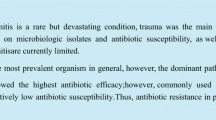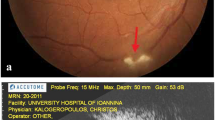Abstract
The purpose of this investigation was to evaluate the performance of blood culture bottles in comparison to conventional microbiological culture techniques in detecting causative microorganisms of endophthalmitis and to determine their anti-infective susceptibility profiles. All consecutive cases with clinically suspected endophthalmitis in a university-based ophthalmology department between January 2009 and December 2016 were analysed in this retrospective comparative case series. Samples from 247 patients with suspected endophthalmitis underwent microbiological diagnostic work-up. All three culture methods were performed from 140 vitreous specimens. Vitreous fluid specimens were inoculated in blood culture bottles, aerobic and anaerobic broth solutions, and on solid media. Anti-infective susceptibility profiles were evaluated by semi-automated methods and/or gradient diffusion methods. Microorganisms were grown in 82 of 140 specimens for which all methods were performed (59%). Microorganisms were more frequently grown from blood culture bottles (55%) compared to broth solution (45%, p = 0.007) and solid media (33%, p < 0.0001). Considerable differences in the performance among culture media were detected for fungal pathogens. All grown fungi were detected by blood culture bottles (11 of 11, 100%). Broth solution recovered 64% and solid media 46% of grown fungi. No Gram-positive bacterium was resistant to vancomycin and all Gram-negative pathogens except for one isolate were susceptible to third-generation cephalosporins. In suspected endophthalmitis patients, blood culture bottles have a higher overall pathogen detection rate from vitreous fluid compared to conventional microbiological media, especially for fungi. The initial intravitreal antibiotic therapy with vancomycin plus third-generation cephalosporins appears to be an appropriate treatment approach for bacterial endophthalmitis.


Similar content being viewed by others
References
Therese KL, Anand AR, Madhavan HN (1998) Polymerase chain reaction in the diagnosis of bacterial endophthalmitis. Br J Ophthalmol 82(9):1078–1082
Goldschmidt P, Degorge S, Benallaoua D, Basli E, Batellier L, Boutboul S, Allouch C, Borderie V, Laroche L, Chaumeil C (2009) New test for the diagnosis of bacterial endophthalmitis. Br J Ophthalmol 93(8):1089–1095
Joondeph BC, Flynn HW Jr, Miller D, Joondeph HC (1989) A new culture method for infectious endophthalmitis. Arch Ophthalmol 107(9):1334–1337
Yospaiboon Y, Saree S, Pasadhika S (2005) Blood culture and conventional media for vitreous culture in infectious endophthalmitis. J Med Assoc Thail 88(5):639–642
Tan HS, Ghyczy-Carlborg EA, Spanjaard L, de Smet MD (2011) The additional value of blood culture bottles in the diagnosis of endophthalmitis. Eye 25(8):1069–1073
Thariya P, Yospaiboon Y, Sinawat S, Sanguansak T, Bhoomibunchoo C, Laovirojjanakul W (2016) Blood culture bottles are superior to conventional media for vitreous culture. Clin Exp Ophthalmol 44(6):488–491
Kratz A, Levy J, Belfair N, Weinstein O, Klemperer I, Lifshitz T (2006) Broth culture yield vs traditional approach in the work-up of endophthalmitis. Am J Ophthalmol 141(6):1022–1026
Duan F, Wu K, Liao J, Zheng Y, Yuan Z, Tan J, Lin X (2016) Causative microorganisms of infectious endophthalmitis: a 5-year retrospective study. J Ophthalmol 2016:6764192
Melo GB, Bispo PJ, Yu MC, Pignatari AC, Höfling-Lima AL (2011) Microbial profile and antibiotic susceptibility of culture-positive bacterial endophthalmitis. Eye 25(3):382–387; quiz 388
Kernt M, Kampik A (2010) Endophthalmitis: pathogenesis, clinical presentation, management, and perspectives. Clin Ophthalmol 4:121–135
Eser I, Kapran Z, Altan T, Eren H, Yilmaz OF (2007) The use of blood culture bottles in endophthalmitis. Retina 27(7):971–973
Pongsachareonnont P, Honglertnapakul W, Chatsuwan T (2017) Comparison of methods for identifying causative bacterial microorganisms in presumed acute endophthalmitis: conventional culture, blood culture, and PCR. BMC Infect Dis 17(1):165
Mollan SP, Gao A, Lockwood A, Durrani OM, Butler L (2007) Postcataract endophthalmitis: incidence and microbial isolates in a United Kingdom region from 1996 through 2004. J Cataract Refract Surg 33(2):265–268
Han DP, Wisniewski SR, Wilson LA, Barza M, Vine AK, Doft BH, Kelsey SF (1996) Spectrum and susceptibilities of microbiologic isolates in the Endophthalmitis Vitrectomy Study. Am J Ophthalmol 122(1):1–17
Pijl BJ, Theelen T, Tilanus MA, Rentenaar R, Crama N (2010) Acute endophthalmitis after cataract surgery: 250 consecutive cases treated at a tertiary referral center in the Netherlands. Am J Ophthalmol 149(3):482–487.e1–2
Jambulingam M, Parameswaran SK, Lysa S, Selvaraj M, Madhavan HN (2010) A study on the incidence, microbiological analysis and investigations on the source of infection of postoperative infectious endophthalmitis in a tertiary care ophthalmic hospital: an 8-year study. Indian J Ophthalmol 58(4):297–302
Kunimoto DY, Das T, Sharma S, Jalali S, Majji AB, Gopinathan U, Athmanathan S, Rao TN (1999) Microbiologic spectrum and susceptibility of isolates: part I. Postoperative endophthalmitis. Endophthalmitis Research Group. Am J Ophthalmol 128(2):240–242
Chakrabarti A, Shivaprakash MR, Singh R, Tarai B, George VK, Fomda BA, Gupta A (2008) Fungal endophthalmitis: fourteen years’ experience from a center in India. Retina 28(10):1400–1407
Liu C, Ji J, Li S, Wang Z, Tang L, Cao W, Sun X (2016) Microbiological isolates and antibiotic susceptibilities: a 10-year review of culture-proven endophthalmitis cases. Curr Eye Res 42(3):443–447
Lingappan A, Wykoff CC, Albini TA, Miller D, Pathengay A, Davis JL, Flynn HW Jr (2012) Endogenous fungal endophthalmitis: causative organisms, management strategies, and visual acuity outcomes. Am J Ophthalmol 153(1):162–166.e1
Labit CM, Claeys GW, Verbraeken HE, Verschraegen GL (2001) Methicillin resistance of bacteria isolated from vitreous fluid from patients undergoing vitrectomy. Eur J Ophthalmol 11(2):160–165
O’Driscoll T, Crank CW (2015) Vancomycin-resistant enterococcal infections: epidemiology, clinical manifestations, and optimal management. Infect Drug Resist 8:217–230
Steinmann J, Hamprecht A, Vehreschild MJ, Cornely OA, Buchheidt D, Spiess B, Koldehoff M, Buer J, Meis JF, Rath PM (2015) Emergence of azole-resistant invasive aspergillosis in HSCT recipients in Germany. J Antimicrob Chemother 70(5):1522–1526
Johnson AP (2011) Methicillin-resistant Staphylococcus aureus: the European landscape. J Antimicrob Chemother 66(Suppl 4):iv43–iv48
Barry P, Luis C, Gardner S (2013) ESCRS guidelines for prevention and treatment of endophthalmitis following cataract surgery. Data, dilemmas and conclusions. Available online at: http://www.sbop.com.br/conteudo/OK%202013%20ESCRS%20Endophthalmitis-Guidelines.pdf
Author information
Authors and Affiliations
Corresponding authors
Ethics declarations
Conflict of interest
The authors declare that they have no conflict of interest.
Ethical approval/informed consent
All samples were taken as a part of standard care procedures; therefore, no written informed consent was necessary for this type of study. The recommendations of the ICH-GCPC guidelines have been followed and the study was performed in accordance with the latest version of the Declaration of Helsinki.
Rights and permissions
About this article
Cite this article
Kehrmann, J., Chapot, V., Buer, J. et al. Diagnostic performance of blood culture bottles for vitreous culture compared to conventional microbiological cultures in patients with suspected endophthalmitis. Eur J Clin Microbiol Infect Dis 37, 889–895 (2018). https://doi.org/10.1007/s10096-017-3182-6
Received:
Accepted:
Published:
Issue Date:
DOI: https://doi.org/10.1007/s10096-017-3182-6




